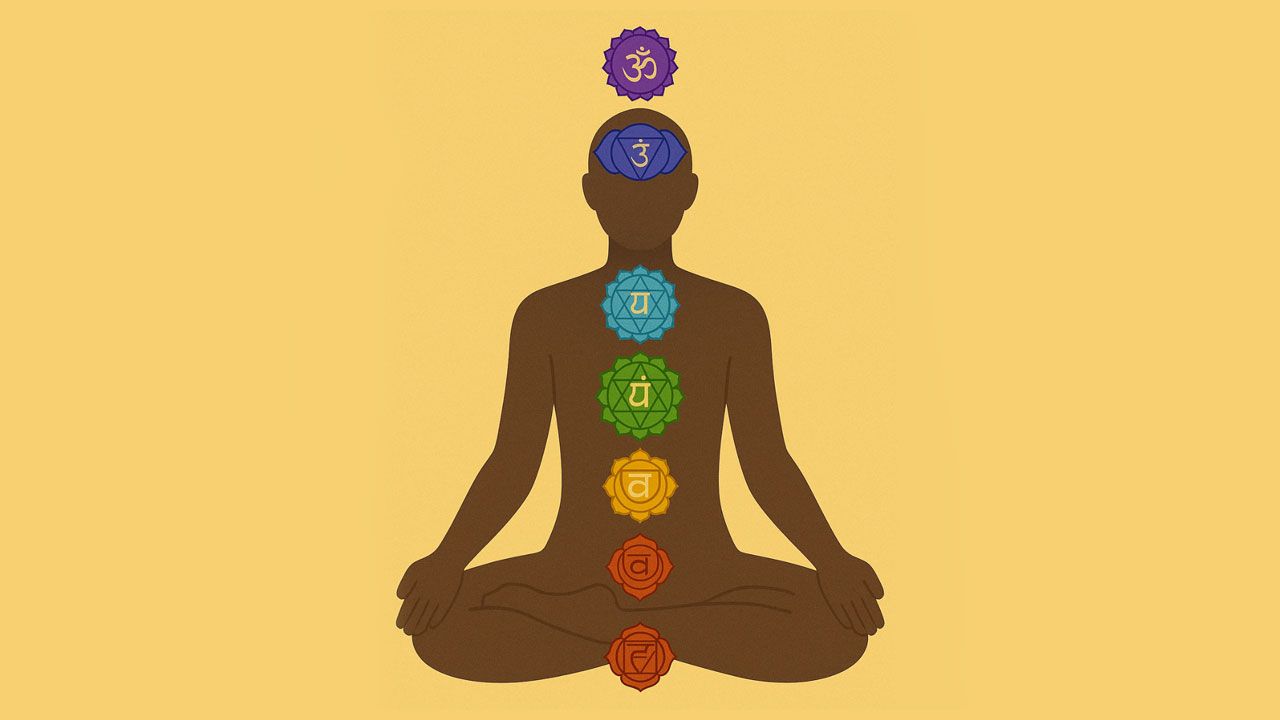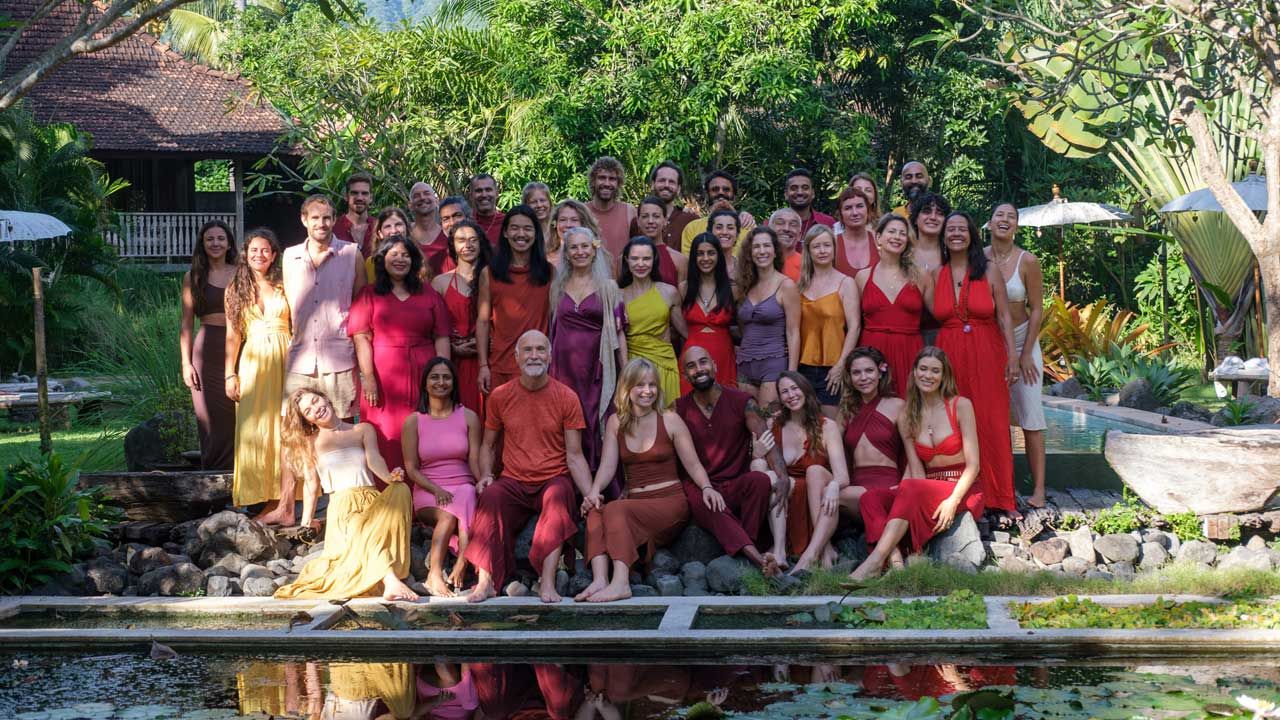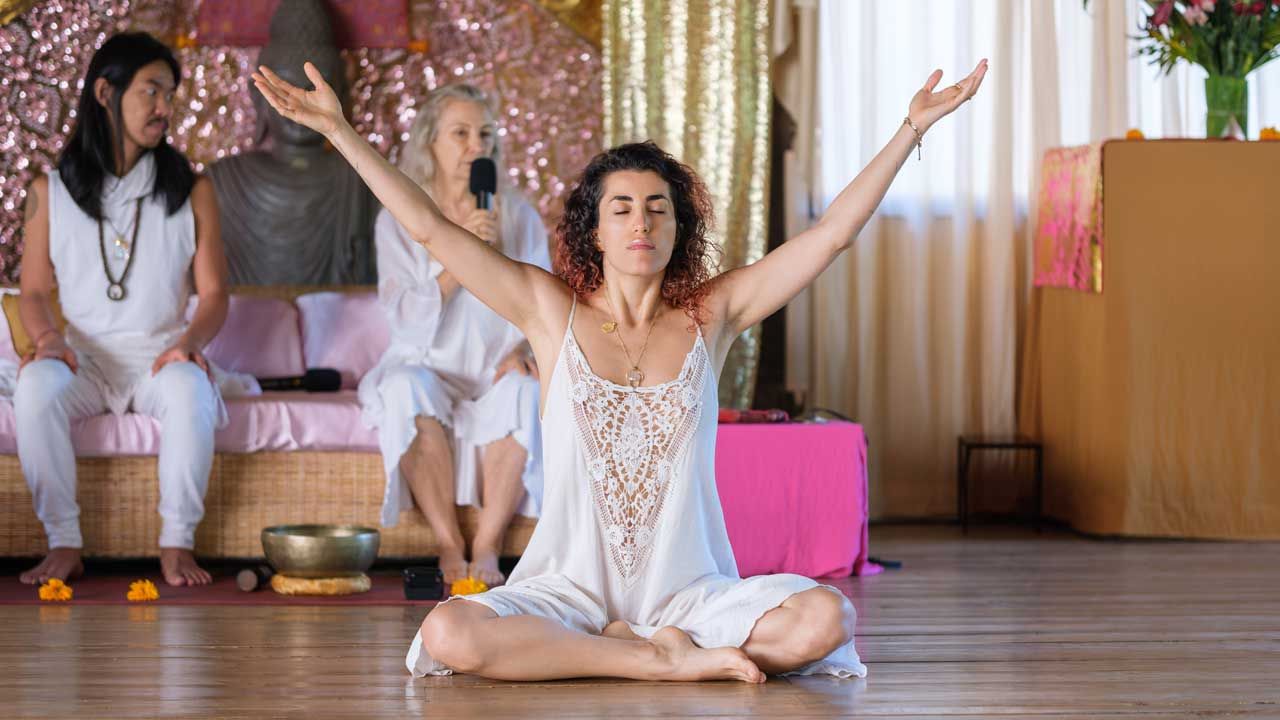The Stages of Samadhi: How to Let Go of Everything
Jun 10, 2025
Samadhi is the moment when everything you believe yourself to be dissolves. It is what remains when all mental constructs collapse.
In Patanjali’s Yoga Sutras, Samadhi is the final threshold, where thought stops, identity disappears, and pure awareness exists without limitation. At first, consciousness still clings to external anchors, breath, mantra, or sensation, before those, too, begin to fade.
As awareness turns inward, thought itself unravels, stripping away the illusion of self. At its deepest level, even the experiencer disappears. No subject, no object, no separation, just undivided consciousness contemplating the whole universe.
How Do You Reach Samadhi?
Samadhi is a state of deep meditative conciousness. It is what’s left when every attachment, every belief about who you are, and every mental construct falls away. The harder you try to grasp it, the further you are from it.
It starts with focus. You bring your awareness to one point, breath, mantra, sensation. At first, the mind fights back. Thoughts keep pulling you in. But the more you sit with it, the more the mind quiets. Instead of being lost in thought, you begin to watch it. That’s the first shift. Awareness moves from being identified with thoughts to simply observing them.
Then, the observer itself, the “I” that’s watching, starts to fade. There’s no longer someone meditating, just meditation happening. No subject, no object. Thought slows until it stops altogether. And when the mind finally lets go, there is nothing left to hold onto. No identity, no separation. Just raw, undivided existence. Individual existence, a lower level of consciousness, is transcended in the process of reaching Samadhi.
History of Samadhi
The concept of Samadhi originates from the ancient Indian spiritual tradition, first documented in the Vedas and later expanded upon in the Upanishads and Patanjali’s Yoga Sutras. The term itself comes from Sanskrit, where “sam-” means together or completely, and “dhi” refers to attention or absorption, signifying total immersion.
While its earliest mentions are in Hinduism, particularly in the path of Raja Yoga, the concept later spread to Buddhism and Jainism. Over centuries, different schools of thought refined the understanding of Samadhi, categorizing its stages and methods of attainment, but at its core, it remains the dissolution of self into the vast, formless awareness that transcends all mental constructs.
Alternate Names for Samadhi Across Traditions

- Nirvana (Buddhism) - The complete cessation of suffering and the end of the cycle of rebirth (samsara), where the ego dissolves, and only peace remains.
- Turiya (Advaita Vedanta) - The “fourth state” of consciousness beyond waking, dreaming, and deep sleep, where one exists in pure awareness, free from identification with the body and mind.
- Satori (Zen Buddhism) - A sudden, spontaneous awakening that reveals reality as it is, without the interference of thought or perception. Unlike Nirvana, Satori is often a temporary glimpse into enlightenment.
- Fana (Sufism) - The annihilation of the self in divine consciousness. The seeker loses all sense of individual identity and merges with the infinite.
- Theosis (Christian Mysticism) - The process of becoming one with God, where the separation between self and the divine dissolves, often described as divine union.
- Moksha (Hinduism and Jainism) - Liberation from the cycle of birth and death (samsara), leading to absolute freedom and the realization of the self as eternal consciousness.
- Kevala Jnana (Jainism) - Pure, absolute knowledge attained when all karmic bonds are broken, leading to an uninterrupted state of awareness and liberation.
- Wu (Taoism) - The state of effortless being and deep harmony with the Tao, where personal will is surrendered, and the flow of existence is fully embraced.
- Peak Experience (Psychology) - A term used by Abraham Maslow to describe moments of deep transcendence, where an individual experiences profound clarity, unity, and presence beyond the ego.
Witnessing Through the Four Brainwave States
To understand the path to Samadhi, we need to look at how the brain itself changes as you go deeper in meditation. Your mind isn’t a fixed state. It moves through four main brainwave frequencies, each associated with a different level of consciousness. In meditation, as the body stills and the mind turns inward, you pass through each of these in sequence, if you remain aware.
Samadhi happens when awareness remains intact all the way through the final layer, when you become conscious of even the most unconscious states.
Let’s walk through them
1. Beta: Waking Consciousness (Thinking Mind)
Beta brainwaves are fast and frequent. This is where most people live all day, thinking, solving, planning, reacting. The nervous system is active. The ego is front and center. This is the "I" that checks your phone, navigates traffic, tries to meditate but keeps getting distracted.
At the beginning of a meditation practice, beta is what you first encounter. Thoughts are loud. Sensations dominate. You may feel an urge to fidget, analyze, or judge the practice. Here’s where witnessing begins: observing the thinking mind without following it. You start to see, “This is not me. This is just thought.”
2. Alpha: Threshold State (Relaxed Presence)
As you breathe more slowly and drop into a focused rhythm, your brain shifts into alpha waves. These are slower than beta and signal a more relaxed, internally directed state. You’re still awake, but not externally focused. Alpha is the place between outer awareness and inner depth.
Here, thoughts soften. Space opens. You begin to feel more still, more internal. This is the entry point into trance, but you're not asleep. If you stay present, this is where you first glimpse yourself as witness, not as the body, not as the mind, but as something watching from underneath.
3. Theta: Dreaming Consciousness (Symbolic Mind)
Theta waves are even slower. These are associated with dreams, intuition, memory, and deep imagination. Normally, you enter theta unconsciously during sleep. But in deep meditation, you move through it with awareness.
The unconscious begins to open. For many, this is where inner child material surfaces, or where spontaneous visions or energetic experiences occur. It can be beautiful, strange, or deeply emotional.
But the practice is the same: stay present. Witness. Don’t get caught in the story. You’re not here to interpret symbols or chase bliss. You’re here to watch.
4. Delta: Deep Dreamless Sleep (Void Awareness)
Delta is the slowest brainwave frequency. In sleep, this is the state of total unconsciousness, no thought, no dream, no time. In meditation, this is where Samadhi becomes possible. The ego is gone. The observer dissolves. There’s no image, no sensation, no experience, and yet, awareness remains.
It’s called witnessing the void. It is a small death. You don’t disappear, but the sense of “I” no longer applies. You aren’t observing anymore. You are.
And this is where true wisdom is born. Ancient traditions describe this as the Akashic field, pure, unfiltered knowledge that doesn’t come through thought, but through direct perception.
The First Stage of Samadhi: Savitarka Samadhi

Savitarka Samadhi is the entry point into deeper meditative absorption, where the mind is still active but channeled into a single, focused stream.
In this state, your awareness is fully absorbed in a gross object, whether it’s your breath, a mantra, a deity, or any tangible meditation object. You’re not daydreaming or letting your thoughts wander aimlessly. Instead, your mind becomes a laser, locked onto one object, analyzing it, contemplating it, and turning it over from every angle.
You’re still in the realm of thought. You’re not beyond the mind, you’re still very much inside it, navigating its landscapes. You’re observing, but you’re also interpreting. You’re seeing the mantra as a word, the breath as an action, the deity as a symbol. Labels still exist. Duality is still in play.
Savitarka Samadhi is focused concentration with the presence of thought. The mind remains active, but it’s restrained and refined, moving in a single direction without scattering.
Yet, this stage is heavily filtered through your existing mental framework, your beliefs, experiences, and memories. If you approach the practice with fear, you’ll see through the lens of fear. If your mind is wired for control, you’ll feel the urge to force stillness. This is why Savitarka Samadhi is as much about observing your mental patterns as it is about the object you’re focusing on.
Savitarka Samadhi is the starting gate, the space where the mind organizes itself around a single focus, preparing for the deeper stages where thought itself dissolves. The goal here is to let the object hold your focus until the mind starts to quiet on its own, until the analysis, the labels, and even the sense of the observer begin to fade.
The Second Stage: Nirvitarka Samadhi

The best way to describe Nirvitarka Samadhi is as a freefall into presence.
The mind no longer clings to concepts, logic, or analysis. In this state, sense perception is transcended, allowing for direct knowledge and unfiltered connection to reality. You’re not “thinking about” reality, but you’re inside it. Direct perception, no filter.
In this state, the mind doesn’t analyze, dissect, or name. You don’t observe the breath and you become it. You don’t perceive space; you are space.
This is where the human mind steps beyond its conditioning and where knowledge is built from a raw, unfiltered connection to reality itself.
Without external distractions, without the constant pull of conditioned thinking, everything becomes clearer. But not in a way that can be explained. Logical understanding is useless here. This is knowing without words, seeing without looking, existing without needing to define it.
At this point, there is no “you” experiencing stillness. There is only stillness.
And yet, this is still only the beginning.
The Third Stage: Savichara Samadhi
Nirvitarka Samadhi is the next stage of deep meditation, where thoughts no longer shape your perception of reality, allowing you to perceive the subtle aspects of existence. In Savitarka Samadhi, the mind was still engaged, analyzing and interpreting objects of focus.
Here, that analytical process falls away. In this state, the mind no longer clings to concepts, words, or logical structures. There is no mental chatter organizing experience. You are fully immersed in direct perception, reality as it is, without the filter of thought.
At first, the mind may resist. It’s used to naming and categorizing everything. But the deeper you settle, the more those impulses dissolve. Awareness remains, but without commentary, without grasping, without a self to experience it.
This is a shift beyond conditioned thinking, beyond the habitual loops of memory and expectation. It’s pure presence, free from the weight of past experiences or mental constructs.
Yet, even here, something remains, a trace of identity, a faint sense of self, still holding on. And as long as that remains, the journey isn’t over. Nirvitarka Samadhi is a profound step, but beyond it lies even deeper dissolution, where the last remnants of self-awareness begin to fade.
The Fourth Stage: Nirbija Samadhi
Nirbija Samadhi, meaning “seedless absorption”, is the final stage where even the subtlest traces of self dissolve completely. In previous stages, awareness was still tethered to some form, breath, mantra, sensation, or even a faint sense of identity. Here, all of it disappears.
At this level, there is no object of focus, no observer, no effort. The mind doesn’t reach for anything because there is nothing left to reach for. The body, the breath, even awareness of meditation itself, all fade into pure, undivided consciousness. In this state, the physical body is no longer a focal point, as the mind transcends its interaction with the physical universe.
To experience something, there must be a self to experience it. But in Nirbija Samadhi, even the sense of “I” dissolves. There is no thought, no form, no distinction between subject and object.
What remains is absolute reality beyond time, beyond identity, beyond even the concept of existence itself.
Those who reach this stage don’t “come back” in the same way. Because the attachment to the body, the mind, the illusion of separation is gone. The endless cycle of struggle, grasping, and identity-building dissolves, revealing something beyond words.
Not bliss. Not emptiness. Not even existence or non-existence. Just… being.
For those who reach this state, the illusion of self ends. Permanently.
The Transition to Sahaja Samadhi
Sahaja Samadhi is the seamless integration of enlightenment into everyday life. Unlike previous stages of Samadhi, where deep meditation was required to enter a state of pure awareness, Sahaja Samadhi is a state that remains effortless and continuous.
Here, there isn’t any need to sit in silence to access it because the separation between meditation and life dissolves completely. Walking, speaking, eating, everything becomes an expression of presence. In this state, actions are no longer driven by personal motive but by a selfless connection to higher consciousness. It’s simply being awareness itself!
For every stage up until now, Samadhi has been an experience, something that happens in deep meditation, a state you enter and exit. But Sahaja Samadhi is where the division between practice and life disappears completely.
Here, there is no struggle to maintain awareness. Divine consciousness integrates so fully into existence that every moment, breathing, walking, eating, speaking flows in absolute presence. There is no effort, no coming in and out, like from meditation. Awareness doesn’t flicker. It doesn’t fade. It’s just there. Always.
And yet, you’re still here. In the world. Moving through it, but untouched by it.
A person in appearance, but something else entirely behind it.
This is where the mind’s final illusions break apart.
Samadhi and the Ultimate Truth
Every spiritual path leads here. Each practice, every moment of stillness, every dissolution of self, it all points to this.
Patanjali described Samadhi as the final goal of yoga, the moment where all separation ends.
Liberation is the moment you recognize and reflect upon your true self, which is essential for achieving enlightenment. It’s the moment you realize there was never anything to be freed from. The body, the mind, the endless cycle of thought, it was all just passing clouds. The sky was always clear.
Most people hear this and dismiss it. They think enlightenment is abstract, impossible. But it’s not. It’s not a privilege for saints and mystics. It is attainable and closer than you think.
Conclusion
Samadhi is the moment when every part of you that has ever tried to hold on, your name, your story, your thoughts, even the one observing those thoughts, vanishes.
What’s left? Just raw, undeniable is-ness.
Achieving Samadhi can be a challenge in its own right. The mind fights tooth and nail to stay in control. It will convince you that you need to hold onto something, an identity, a belief, even the idea of being aware.
It will tell you that letting go means disappearing into nothingness. The process burns away everything false. What’s left cannot suffer, because suffering belongs to the illusion of separation. It cannot fear, because fear belongs to the mind. It cannot be destroyed, because it was never born.
And if you’ve felt it even for a second, you know there’s only one question left:
Will you let go?
FAQ
Samadhi unfolds in progressive stages, each stripping away layers of identity, thought, and perception. The first stage, Savikalpa Samadhi, still involves form, consciousness is absorbed in an object of meditation, whether breath, mantra, or a concept. Awareness is heightened, but the observer still exists. As practice deepens, Nirvikalpa Samadhi arises, where all mental activity ceases, and awareness is left without an anchor. There is no object, no thoughts—just pure existence. Going further, Dharmamegha Samadhi brings the dissolution of egoic consciousness entirely. There is no division between self and reality, only an all-encompassing presence. The final stage, Kaivalya, is absolute liberation, beyond mind, beyond duality, beyond return. At this point, there is no experiencer left to identify with the process; existence simply is.
The path to Samadhi is laid out in Patanjali’s Yoga Sutras through the Ashtanga, or the Eightfold Path. It begins with Yama and Niyama, which establish ethical and personal discipline, preparing the mind and body for deeper practice. Asana follows, not as physical exercise but as the ability to sit in stillness without distraction. Pranayama refines breath control, regulating the life force and shifting awareness inward. From there, Pratyahara withdraws the senses, detaching consciousness from the external world. This leads to Dharana, a state of focused concentration, and then Dhyana, true meditation, where thoughts no longer disrupt awareness. Finally, Samadhi emerges, not as a moment of effort, but as the collapse of all effort, where individual self dissolves into absolute consciousness.
There is no set time limit for Samadhi, it varies by the depth of absorption and the individual’s level of practice. In early stages, it may last for moments or minutes before the mind reasserts itself. As practice deepens, one may remain in this state for hours, seemingly without perception of time. Advanced yogis have been recorded in deep Samadhi for days, weeks, or even permanently, where the body remains alive but awareness is no longer tied to it. Some traditions describe final Samadhi as an irreversible state where the body itself becomes irrelevant, dissolving into the elements as consciousness merges completely with the infinite.
As the mind detaches from identification with the body, physiological changes occur. In the beginning stages, breath slows dramatically, sometimes becoming imperceptible. The nervous system shifts into deep stillness, and physical sensation may disappear entirely. Advanced practitioners have shown decreased metabolic function, lowered heart rate, and an ability to remain without movement or external awareness for extended periods. In deeper Samadhi, the body enters a suspended state where it continues to function, but the consciousness that once animated it is no longer confined within it. In the highest forms, some masters have remained in Samadhi until the body itself ceases to function, dissolving naturally without suffering.
The time it takes to reach Samadhi is impossible to measure, because it depends entirely on the individual. Some reach glimpses of it within years of practice, others in moments of spontaneous surrender, and many never reach it at all. The mind’s grip on identity and attachment is what determines the timeline—not effort, not technique, but the willingness to let go of everything. For some, lifetimes of practice may still not be enough, while for others, the realization strikes like lightning, bypassing the gradual process altogether. The truth is, Samadhi isn’t achieved, it’s revealed when everything that blocks it is stripped away. How long that takes depends on how much you're willing to surrender.















